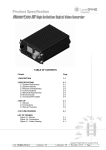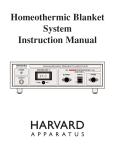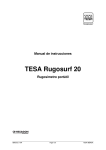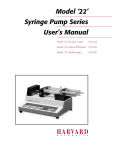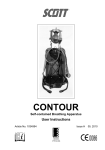Download Pyser PNP-MC Operator`s manual
Transcript
PYSER-SGI LIMITED PNP-MC Pocket Scope Operator’s Manual YSER-SGI LIMITED Fircroft Way, Edenbridge, Kent United Kingdom, TN8 6HA Telephone: +44 (0) 1732 864111 Facsimile: +44 (0) 1732 865544 Email: [email protected] www.pyser-sgi.com NSN: 5855-99-855-1401 560 - 007 - 51 100/03/09 Chapter 5. Accessorie Mounting 5.3 PNP-MC with head mount / helmet mount fitting guide 1. 2. WARNING 3. LIMITED WARRANTY This product contains an image intensifier tube. The manufacturer of this POCKET SCOPE, has provided a limited warranty to the original purchaser. It was attached to the manufacturer’s terms and conditions of sale. Permanent damage to the tube may result if the product is used in normal room illumination or bright ambient light. Do not direct it at a bright light source such as the sun, street or vehicle lights or over an extended period toward another bright light source or stationary scene which could lead to permanent damage to the image intensifier tube. 4. 5. 6. 7. 8. 9. Attach monocular to the mount with thumbscrew A Depress plunger B to lift monocular into the vertical position (where it will automatically shut off) Adjust pitch setting of the monocular with thumbscrew C Adjust height setting of the monocular with thumbscrew D Adjust lateral setting of the monocular with thumbscrew E Adjust forward/backward setting of the monocular with thumbscrew F For rapid removal of the monocular, fully loosen thumbscrew F, depress plunger G and slide the assembly off its mounting slide away from the face. For safe stowage, press the lens cap, when not in use, onto pin H. For fine adjustment of pitch slacken screws J move monocular to desired attitude and re-tighten screws. PNP-M - Operator’s Manual 21 Chapter 5. Accessorie Mounting 5.2 PNP-MC with switching mount 1. 2. 3. 4. Fully unscrew thumb knob C to the end stop Remove the slider block assembly, rotate its orientation accordingly Re attach and tighten thumbscrew C TIP to get maximum tightness, tighten thumbscrew C whilst monocular is at its maximum pitch travel (UP for R/H & DOWN for L/H) then complete tightening whilst turning knob C and simultaneously rotating the monocular into the desired pitch setting. TABLE OF CONTENTS Page Chapter 1 Description 1.1 System description 1.2 Specifications 1.3 PNP-MC standard equipment and accessories 1.4 PNP-MC main parts Chapter 2 Operating Instructions 2.1 Battery installation 2.2 Operation 2.3 PNP-MC applications 2.4 PNP-MC operation with DSLR and SLR cameras 2.5 PNP-MC operation with video cameras / camcorders 2.6 PNP-MC operation with CCTV cameras Chapter 3 Troubleshooting 3.1 General 20 PNP-MC - Operator’s Manual PNP-MC - Operator’s Manual 2 3 4-5 5-6 7 7 7 8 10 11 11 Chapter 4 Accessories 4.1 Accessories for PNP-MC Relay Lens Shuttered Eyeguard HeadHarness Helmet Mount Bridge Kit Weapon Mount Anti-Mist 150mw Illuminator, IR LED Lanyard Camcorder/Camera Adaptor Optical Module Camera lens to C-mount Adaptor 12v Car Cigarette Plug/Lead 15 15 15 15 16 16 16 17 18 18 18 18 18 19 19 Chapter 5 Accessorie(s) Mounting Instructions 5.1 Dual Monocular Mounting 5.2 PNP-MC with Switching Mount 5.3 PNP-MC with Head Mount/ Helmet mount fitting guide 19 19 20 21 13 14 1 Chapter 1. Description Chapter Chapter 5. Accessorie Mounting 1 DESCRIPTION 1.1 System description PNP-MC is a powerful, multi-purpose, lightweight, pocket-sized monocular night scope utilising C-mount CCTV lenses for extra flexibility. The pocket scope is designed to be used either as a stand-alone night vision device or in combination with a wide variety of standard video, still-photo or CCTV equipment. insufficient - especially effective inside buildings etc. Special purpose adaptors enable the PNP-MC to be mounted onto a wide variety of SLR and video cameras (including CCTV cameras). Thus, standard photographic equipment can be quickly turned into powerful, effective night-time devices, dramatically enhancing your intelligence gathering and observation capability. As a stand-alone night scope, PNP-MC is small and lightweight enough to be unintrusive. It may be easily hand-held. ACCESSORIE(S) MOUNTING INSTRUCTIONS Camera lens to C-mount adaptor (see # 2 of 2.4.3) Attaches original camera lens directly to PNP-MC body in place of CCTV lens T2 lenses Part No: 589-840-403 M4 lenses Part No: 589-840-404 Canon FD lenses Part No: 589-840-405 Pentax K lenses Part No: 589-840-406 Nikon lenses Part No: 589-840-407 Minolta MD lenses Part No: 589-840-409 Olympus OM lenses Part No: 589-840-410 5.1 Dual monocular mounting Others available on request The PNP-MC is a powerful tool for covert night-time observation and intelligencegathering purposes using standard photographic media, as well as an effective aid to night-time field missions. PNP-MC employs an image intensifier tube characterized by high resolution and a clear, bright image. It is equipped with its own IR LED - type illuminator, which provides additional, close-range covert illumination, when ambient light is 2 Chapter 5 12v Car Cigarette Plug/Lead 2 outputs (needs 560-012), powers PNP-MC from vehicle Part No: 560-011 PNP-MC - Operator’s Manual PNP-MC - Operator’s Manual ATTACH THE TWO MONOCULARS TO THE BINOCULAR MOUNT USING THE TWO THUMBSCREWS. THE BINOCULAR CAN ATTACH TO THE HEAD & HELMET MOUNTS IN THE SAME WAY AS A SINGLE MONOCULAR ON ITS SWITCHING MOUNT. 19 Chapter 4. Accessories Chapter 1. Discription 1.2 PNP-MC Specifications Dimensions Optical Camcorder/Camera Adaptor Anti-Mist for eyepiece NSN 5855-99-341-1382 Part No: 560-007-010 30mm 30.5mm 35mm 49mm 52mm 58mm 72mm Part Part Part Part Part Part Part No: No: No: No: No: No: No: 589-840-300 589-840-305 589-840-035 589-840-042 589-840-041 589-840-058A 589-840-072 Others available on request 150mw Illuminator, IR LED wide, mid and narrow FOV, 805nm. Effective distance up to 280 metres with Gen 2 and Gen 3 devices. NSN 6650-99-731-1262 Part No: 583-340 Lanyard Part No: 589-855 Optical Module (see # 4 of 2.4.3) Attaches PNP-MC directly to camera body Nikon Part No: 589-840-400 Canon EOS Part No: 589-840-401 Pentax Part No: 589-840-402 Others available on request 18 PNP-MC - Operator’s Manual Magnification: Field of view: Focus range (m): Objective focal length (mm): Objective F number: Dioptre adjustment: Eyepiece lens: Eye relief Physical 1x 40 Degrees 0.25-infinity Weight 25mm C-mount F1.4 Minimum +3 to - 6 25mm glass aperture 27mm Tripod mount Electrical Power source Single 1.5 V ”AA” battery or 1.5V “AA” format lithium type L91 (NSN 6135 01 333 6101) or 1.2V”AA” size rechargeable Battery life: In excess of 40 hours dependent on tube and battery type IR on indicator Red LED in eyepiece Low voltage indicator Yellow LED in eyepiece PNP-MC - Operator’s Manual Construction Eyeguard 42 mm wide x 67 mm high x 114 mm long (with folded eyecup) 293 gms without battery 308 gms with lithium “AA” battery 318 gms with commercial “AA” battery Weight includes eyecup and lens cap Standard ¼” UNC thread Moulded glass filled polymer Contoured soft fold back rubber eyecup Environmental Waterproof Temperature Immersion proof 20m 1hr, (only with waterproof lenses) Nitrogen filled Operation -45°C to +55°C Storage -51°C to +65°C 3 Chapter 1. Description Chapter 4. Accessories 1.3 PNP-MC Standard equipment and accessories Fig. No. 1 - PNP-MC standard kit 3 No. Equipment Qty (1) PNP-MC pocket scope 1 (2) Eye guard 1 (3) Carrying pouch 1 (4) 1.5V “AA” size battery 1 (5) Operator’s manual 1 TABLE NO. 2 PNP-MC Optional accessories Equipment 1 4 2 4 5. The PNP-MC can be removed, if necessary, from the mount and the mount left on the weapon in it’s correct position for next use. TABLE NO. 1 PNP-MC Standard equipment list Adaptors for SLR and DSLR cameras Adaptors for Camcorders CCTV (CCD) relay lens Face-mask Helmet mount Lanyard Various adaptors for Picatinny or Weaver rails Bridge Kit to convert to binoculars Hard carrying case Please see data sheet for full list of accessories for PNP-MC PNP-MC - Operator’s Manual D E A Interface for fitting PNP-MC to Picatinny rail NSN 5304-99-574-0422 Part No: 589-997M Instructions for use 1. Place the PNP-MC rail adaptor on to the Picatinny (or Weaver) rail and lock it in position in a suitable position on the rail using the over-centre lever “A”. 2. Position the PNP-MC on the adaptor so that it is located both by the side support “B” and also by the channels “C”. Use the finger knob “D” so that the PNP-MC is fully and firmly tightened down onto the adaptor. 3. Adjust the fore/aft position of the PNP-MC on the adaptor for optimum eye relief by unscrewing the two Allen bolts “E” and moving the upper part of the adaptor into the best position for the firer. It is essential that two bolts are used and are firmly tightened. One bolt is not sufficient. 4. If necessary, to optimise eye relief, reposition the entire mount on the Picatinny rail by using the over-centre lever. PNP-MC - Operator’s Manual 6. Remember to use day sights in front of the PNP-MC, not behind it between the firer and the PNP-MC and that any day sight with an illuminated aiming mark must be “Night Vision Compatible”. The intensity of the aiming mark must be turned down to the minimum otherwise a burn mark on the image intensifier tube will result. B C N.B. Although PNP-MC can be used on head/helmet and weapon mounted applications, this is not advised except for emergency use, in view of the standard lens not being waterproof nor resistant to recoil shocks of weapons. PNP-M is the recommended product for those applications. 17 Chapter 4. Accessories Chapter 1. Description 1.4.1 Objective lens 1.4 PNP-MC Main parts Fig. No. 2 PNP-MC Parts description Standard objective lens in a 25mm F1.4 C-mount lens. (Any C-mount lens can be used). 6 5 Head Harness for left and right eye use and accepts binocular bridge NSN 6650-99-407-0566 Part No: 550-006/AM 16 For dual monocular mounting please see chapter 5 for fitting instructions. PNP-MC - Operator’s Manual The PNP-MC utilizes a range of tubes characterized by low weight and high gain, which also reduces the dazzle effect which normally occurs when viewing a bright light source through an image-intensifier night scope. 1 9 4 (1) (2) (3) (4) (5) (6) (7) (8) (9) 8 7 3 Bridge Kit Bridge Kit converts two PNPMC’s into binoculars NSN 5340-99-934-5341 Part No: 560-007-008 2 Helmet Mount universal fitting for ballistic helmets. for left and right eye use and accepts binocular bridge NSN 5340-99-812-6225 Part No: 550-006/HM 1.4.2 Image intensifier Pocket scope Objective lens “C” mount Eye guard Eyepiece (diopter ring) Operating switch Battery compartment cover Mount I.R. LED Bright Light Sensor PNP-MC - Operator’s Manual 1.4.3 Eyepiece assembly The eyepiece has a 27mm eye relief and a diopter adjustment of +3 to -6 diopter. A flexible rubber eye guard can be folded back to enable interfacing the PNP-MC to 35mm SLR and video cameras (including CCTV cameras) using special-purpose adaptors fitted to the same threading. 5 Chapter 1. Description 1.4.4 I.R. LED Illuminator The PNP-MC is equipped with a built-in I.R. LED-type illuminator which provides additional, close-range covert illumination when ambient light is insufficient. The illuminator is activated using the operating switch. 1.4.5 Operating switch Operation of the scope is controlled by a three-position rotary switch: OFF - All power off. ON I.R - The scope is on enabling night vision. - The scope is on and the built-in I.R. LED illuminator is activated. Chapter 4. Accessories 1.4.6 Bright Light Protection The image intensifier tube is protected against bright lights by a Bright Light Sensor. The PNP-MC can be switched on, with caution and only for a few seconds, in indoor artificial lighting, but the Bright Light Sensor will switch the PNP-MC off in daylight, only allowing it to be switched back on when the light level falls. This protection is in addition to the internal bright light protection of the image intensifier tube which only reduces the gain and which does not switch the tube completely off. It can be disarmed for daylight training by covering the sensor orifice with a small piece of electrical tape to prevent daylight entering. Chapter 4 ACCESSORIES 4.1 Accessories for PNP-MC Before any accessories are fitted to the eyepiece, fold back the eyecup to expose the mounting thread. “FOR SAFETY, THE I.R. CAN ONLY BE SWITCHED WHEN THE SWITCH KNOB IS FIRMLY PULLED OUT BEFORE TURNING” “A RED LIGHT SHOWS IN THE EYEPIECE TO ALERT THE USER TO THIS FACT” Relay Lens for use with CCTV camera NSN 5836-99-366-5780 Part No: 550-003F Shuttered Eyeguard NSN 6650-99-789-6513 Part No: 550-007 6 PNP-MC - Operator’s Manual PNP-MC - Operator’s Manual 15 Chapter 3. Troubleshooting Chapter 2. Operating Instructions Table No. 4 General troubleshooting 2.1 Battery installation Chapter 2 1) No Symptom Cause Probable Actions Corrective 1 No visible image a. Objective lens cap has not been removed. b. Battery cover loose. c. Incorrect Battery polarity. d. Weak Battery. a. Remove cap. e. Iris closed 2 3 Persistent Image Flickers. Poor image quality a. Faulty intensifier tube. a. Dirty or fogged objective lens. b. Eyepiece out of focus 14 b. Tighten cover. c. Re-insert Battery correctly. d. Replace Battery e.Open Iris a. Send unit to repair/ maintenance facility. a. Clean lens with lens cleaning tissue. If lens is internally fogged, send unit to repair/maintenance facility Adjust diopter ring to bring picture into focus PNP-MC - Operator’s Manual OPERATING INSTRUCTIONS 2) 3) CAUTION 4) 5) The PNP-MC is a delicate electro-optical device - handle it with care! Ensure operating switch is in OFF position. Open battery compartment cover by unscrewing cap. Insert battery into compartment, notice the polarity marking (see Fig. No. 3). Close battery compartment cover A low battery warning indicator is built into the PNP-MC which gives an amber glow at the edge of the image when looking through the eyepiece. 2.2 Operation WARNING Permanent damage to the PNP-MC may result if the PNP-MC is used in normal room illumination or bright ambient light. Do not direct the PNP-MC at a bright light source such as the sun, street lights, vehicle lights, or other bright light source, otherwise permanent damage may occur to the image intensifier tube. PNP-MC - Operator’s Manual 1) 2) 3) 4) 5) 6) Prior to use remove protective lens cap. Turn the operating switch to ON. Adjust eyepiece diopter until the sharpest phosphor screen is obtained. Adjust objective lens focus ring while observing an object until the sharpest image is obtained. - Repeat 3 if necessary Ensure that the iris is open on the lens. To activate the I.R. illuminator turn the operating switch to ON, then pull outwards and turn further to the I.R. position. When the I.R. illuminator is switched on a red LED warning glow can be seen at the edge of the image when looking through the eyepiece. 7 Chapter 2. Operating Instructions Chapter 3. Troubleshooting 2.7 PNP-MC Lens options Fig. No. 3 Battery installation 1) PNP-MC is designed to accept any C-mount lens. 2) PNP-MC can accept photographic lenses from most manufacturers by using a camera lens to C-mount adaptor. See chapter 4 Accessories. 3) “Off-On-I.R.” switch 2.4 PNP-MC Operation with DSLR/SLR cameras (interchangeable lenses) 2.4.1 Installation 1) 2.3 PNP-MC Applications 2) Fig. No. 5 PNP-MC Applications 3) 8 The camera lens to C-mount adaptor ensures the iris is always fully open. Chapter 3 TROUBLESHOOTING 3.1 General Troubleshooting The following table presents faults which may occur in the PNP-MC. In case of malfunction, identify the matching description under the Symptom heading and carry out the corrective actions until the fault disappears. If the fault cannot be corrected by carrying out the specified actions, transfer the PNP-MC to a repair/ maintenance facility. Use any DSLR/SLR camera with it’s lens set to 35-50mm focal length. Load a high sensitivity film B/W (400+1600 ASA) if the camera is a film camera and set the camera accordingly. Digital cameras should be set at the highest ASA if option available Mount the DSLR/SLR adaptor to the PNP-MC eyepiece, (after folding back the eyeguard). PNP-MC - Operator’s Manual PNP-MC - Operator’s Manual 13 Chapter 2. Operating Instructions 2.6 PNP-MC Operation with CCTV cameras Chapter 2. Operating Instructions Fig. No. 8 PNP-MC Installation on CCTV camera 5) 2.6.1 Installation 1) 2) Mount the CCTV relay lens to the PNP-MC eyepiece (after folding back the eye guard). Mount PNP-MC with relay lens to the CCTV camera. CCTV CAMERA 2) 3) 4) 12 Direct the system to the required scenery. Turn PNP-MC and CCTV camera on. Adjust eyepiece diopter until sharpest picture is obtained in the monitor. Adjust objective lens focus ring while observing an object until the sharpest image is obtained in the screen. Mount the PNP-MC, with the DSLR/SLR adaptor. Install the system onto a tripod, if required. Fig. No. 6 PNP-MC Installation on DSLR/SLR camera lens DSLR/SLR CAMERA CCTV RELAY LENS 2.6.2 System operation 1) 4) PNP-MC POCKET SCOPE 2.4.2 System operation 1) Set the DSLR/SLR camera objective lens to the infinity mark (∞); aperture to its maximum opening. 2) Direct the system to the required scenery. 3) Turn PNP-MC on. 4) Adjust eyepiece diopter until the sharpest phosphor screen is obtained through the DSLR/SLR eyepiece. 5) Adjust objective lens focus ring while observing an object until the sharpest image is obtained through the DSLR/SLR eyepiece. 6) Adjust the shutter speed according to the DSLR/SLR lightmeter. SLR RING ADAPTOR OBJECTIVE LENS PNP-MC - POCKET SCOPE PNP-MC - Operator’s Manual PNP-MC - Operator’s Manual 9 Chapter 2. Operating Instructions Chapter 2. Operating Instructions 2.4.3 PNP-MC / camera using original camera & lens 1 3 4 2 2) DSLR Optical Module DSLR Lens DSLR Lens mount 1) Remove original lens from camera (5).and set it to “Manual”. 2) Fit appropriate optical module (4) directly to camera then after folding back rubber eyecup attach module to PNP-MC (3). 3) Attach camera lens to C-mount adaptor (2) to PNP-MC (3). and re-attach original camera lens 4) The C-mount adaptor will have opened the lens iris to maximum. Set the camera film speed to maximum, at least ISO 1600 and use optimum shutter speed (60th or 100th are good starting points). The Night Vision device gives a constant night vision picture brightness so once settings have been established 10 objective lens). Check the markings on your video camera lens. The filter thread diameter is normally marked on the end. 5 PNP-MC body (C-mount lens removed) DSLR Camera body they will apply in most situations. (Tests are recommended to determine optimum settings). Then for operation see 2.4.2 paying special attention to adjusting the PNP-MC eyepiece dioptre setting to give the sharpest picture. It is then left at that setting irrespective of camera lens focus settings. 3) 4) Mount the video camera ring adaptor to the PNP-MC eyepiece (after folding back the eye-guard). Mount the PNP-MC with the adaptor, to the video camera objective lens. Install the system onto a tripod, if required. Fig. No. 7 PNP-MC Installation on video camera/camcorder 2.5.2 System operation with video camera 1) Direct the system to the required scenery. 2) Turn PNP-MC and video camera on. 3) Adjust video camera zoom until full PNP-MC phosphor screen is seen in the video camera view finder. 4) Set PNP-MC eyepiece diopter to midway. 5) Adjust objective lens focus ring while observing an object until the sharpest image is obtained in the video camera view finder. VIDEO / CAMCORDER 2.5 PNP-MC Operation with video camera/camcorder 2.5.1 Installation 1) PNP-MC POCKET SCOPE Use any video camera (Sony, Sanyo, Panasonic etc.) You will need appropriate 28mm to x adaptor (x = filter thread on video camera PNP-MC - Operator’s Manual VIDEO CAMERA RING ADAPTOR PNP-MC - Operator’s Manual 11












